Guilie Castillo-Oriard's Blog, page 26
May 5, 2013
Perú, Perú!
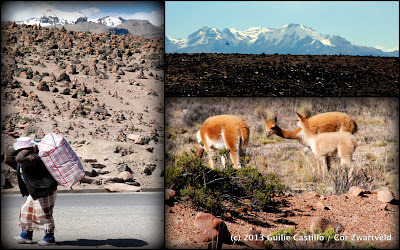 Sometimes, delayed gratification is a good thing.
Sometimes, delayed gratification is a good thing.It took me close to 20 years to come to this mystic land of llamas and icy peaks that hem in the land, of soft-spoken people so very proud of their Inca ancestry; of food so varied, so fine, flavor so delicate, the only thing that comes close to it is the genteel demeanor of the people.
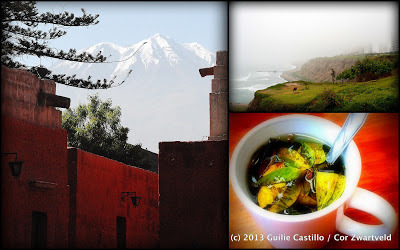 This country of foggy coastland, of gigantic volcanoes as alive today as when the Inca believed them to be breathing gods of sizzling tempers that required the ultimate sacrifice to be appeased, of green mountains and forest so high above sea level coca tea is the only way to keep from passing out.
This country of foggy coastland, of gigantic volcanoes as alive today as when the Inca believed them to be breathing gods of sizzling tempers that required the ultimate sacrifice to be appeased, of green mountains and forest so high above sea level coca tea is the only way to keep from passing out.And, in the west, the obscene fertility of the Amazon rainforest.
Perú reminds me of México in a dèja vu so violent it might give me vertigo if it weren't so pleasant.

There's the obvious ways: the people--the amabilidad, the attitude towards service, the discreet efficiency, the respectfulness.
The variety of the food. Ingredients are different, as are the end results (there's no anticuchos in México, or quínua, and Perú doesn't use tortillas or other products of maíz nixtamalizado ), but the similarity is in the style. The use of sauces, for example.
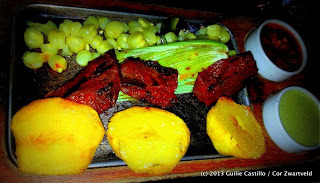 Anticuchos. Note the yellow sauce on the right?
Anticuchos. Note the yellow sauce on the right?That's huancaína, and it's de-li-cious.The use of chile--and, although Peruvians have different names for their chile, I'm pretty sure they're, at most, varieties of the same ones we use in México. Very few countries in South America--or anywhere else, for that matter--use chile like México. Colombia, for example, doesn't use it at all. Venezuela uses a mild variety, and only in a separate sauce meant to be added in very small amounts to certain kinds of food. Perú is the only one I know that uses it in the Mexican way--for flavor.
The variety in climate and regions is another obvious similarity: few countries have the range of climates Mexico has--from unblemished Caribbean beaches of powder-fine sand to high plateaus to forests to rainforest to deserts and dry-as-dust sierras. Well, Perú has them all--except the Caribbean beaches, but I hear the ones in the north might give Aruba a run for her money.
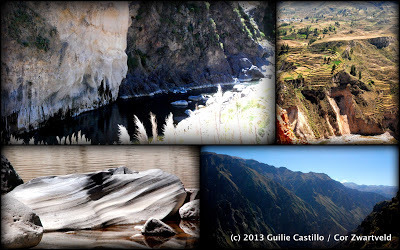 Cañon del Colca: a single location, three (sometimes four)
Cañon del Colca: a single location, three (sometimes four)different climates.But the main similarity I find, the one that might perhaps not be so obvious--not to the non-Mexican traveler--is the way of life. Social idiosyncrasy in Perú is so like the Mexican mindset that it blows my... well, mind. I think it stems from the unique circumstances surrounding the coming of the Spanish to both Mexico and Perú.
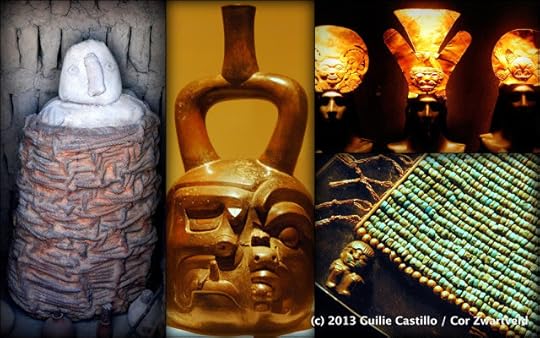
Both countries had a sophisticated culture thriving at the time of the Spanish arrival, which--in both cases--the Spanish sought to eradicate. They murdered the royalty and religious leaders, the scribes, the elite that held the keys to the culture's knowledge accrued over centuries, and they enslaved the rest under the guise of catechism. This segment of the population survived because they were quick to understand life depended on obedience, on--at least the appearance of--submission.
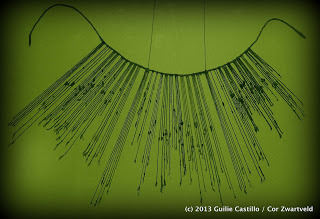 Quipú
, the Inca writing system. First on the Spanish
Quipú
, the Inca writing system. First on the Spanishmurdering agenda: kill the scribes, the only ones that
could interpret them.That submission, and its psychological consequences, has defined the Mexican soul for five centuries. The proud Mexica had to bow their heads, acknowledge themselves as inferior, at the mercy of what they considered barbarians. The result is a complex idiosyncrasy of a sort of guilty pride, a stubborn sense that the shame we feel for the native blood in our veins is wrong--and yet we do, we feel ashamed. Mexican social and political conflict, at its root, comes from this.
And I found it in Perú as well. Though Perú seems to be handling it much, much better. The economy is solid, social conscience is strong, national identity--thanks in perhaps large, perhaps small, part to Gastón Acurio and his cuisine magic--seems on the rise, but at the same time I perceived a strong sense of tolerance towards diversity. That is crucial in countries like Perú and México, where the endemic population is so incredibly diverse.
There's a sense of mystery to Perú that enchants. A feeling of magic that seeps under your skin. I know some people who've been to Perú and fallen in love--now I understand why.

Published on May 05, 2013 17:24
April 5, 2013
A to Z: F is For Fun

So what does one do for fun in Curaçao?
Happy Hours!
I should probably clarify. You know how your neighborhood bar has "happy hour," with drinks two-for-one or something? And it usually happens like in the middle of the afternoon, or an otherwise slow time of the day? You walk in (by mistake, usually) and it's still pretty slow?
Happy hours in Curaçao are not like that.
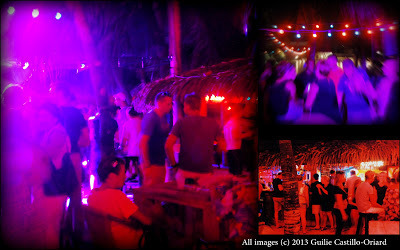 Wet n' Wild. No, really. That's the name of the bar.
Wet n' Wild. No, really. That's the name of the bar.There's happy hours at several places throughout the week, but the rocking ones are on Friday. Technically they last for an hour, but only as far as the cheapo drinks are concerned. Place gets packed during the actual discounted-drinks phase (5 to 6, usually), but no one leaves when the bar starts ratcheting the prices back up.
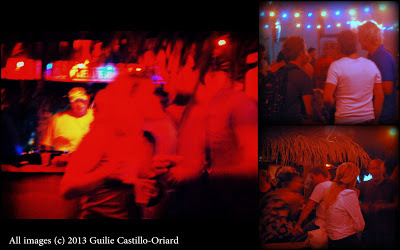
If there's food available, you'll probably stay until 10 or so. Otherwise, after all that beer you drank, well... Let's just say you'll probably make it an early night.
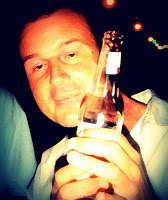
Snèkies!
Snèk is local spelling for "snack." Dutch tends to be somewhat like Spanish in that everything good is turned into a diminutive, thus: snèkie.
But no, we're not talking about snacks. These places might sell food, but plates piled high with Dominican comfort food hardly qualify as a snack. And that's the key: snèkies are run by Dominican women, at the very least Colombian. Otherwise it's not a snèk, period.
What makes these places special? Well, Latin hospitality, certainly. Dominican (and Colombian) women have made a name for themselves in Curaçao as sexy and flirtatious, which drives Dutch men (maybe all men?) completely gek (do I really need to translate?).
The other distinguishing trademark of a snèk is the music. BACHATA! Which is, of course, Dominican.
Snèkies, if you can put up with non-stop bachata (every song sounds the same, I swear) are fun. Laid-back, relaxed, casual. Which is good, because us non-Dominicans need a lot to even try that two-step four-step sideways back-front thing.
Not a bachata lover? No problem. There's more than enough to choose from. Our favorite is Miles, a jazz bar. The only jazz bar in Curaçao.
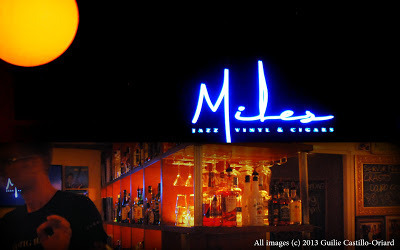
Beach BBQs! (hand in hand with Diving!)
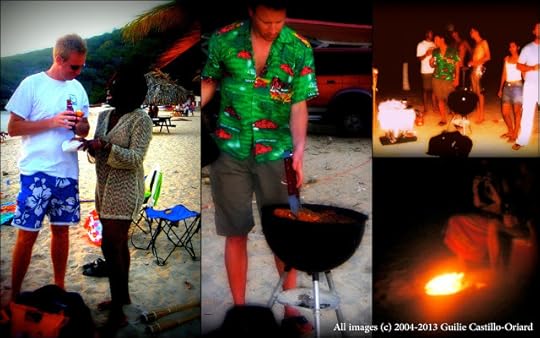
The first thing you must do when coming to Curaçao, especially if you plan on staying, is to find--fast--some South Cone friends. Chile, Argentina, Uruguay. No one can grill meat like them. No, I mean it. I'm absolutely 100% serious about this.
If said South Cone friends also happen to be divers, you've got your weekends covered. No better spot for an asado than the beach, and no meat (or beer, or chips, or anything) tastes better than after a double dive on the amazing reefs of Curaçao.
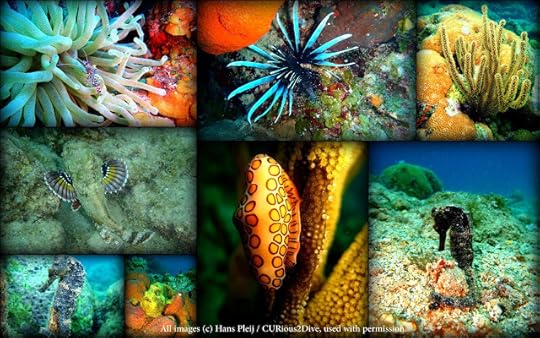 Thank you, Hans, for the brilliant photos!
Thank you, Hans, for the brilliant photos!If you're ever in Curaçao, contact Hans Pleij--he's not just an awesome photographer; he's also the best
dive instructor and guide on the island. Maybe--no, not exaggerating--in the world.F, sadly, is also for FAIL. This will be my last (formal) A-Z post. There's too much going on--editing, copywriting, vacation to Perú, dog rescuing--and I can't keep up. I know, I should've pre-written (I swore I would), but I didn't, and... well.
I was so excited about sharing Curaçao with you all, dang it. I will write the posts I planned, though, and publish them later, but it's gek to think I'll be able to complete the challenge. Thank you, all you faithful followers, all you new visitors, for coming by. I hope you'll be back after April--we'll catch up then :)
Published on April 05, 2013 23:00
April 4, 2013
A to Z: E is for Ee-eh!
Two things will set you apart from regular (i.e. ignorant) foreigners in Curaçao: using Dushi, which you learned about yesterday, and Ee-eh!
It sounds like this:
 Ee-eh! That's a big-ass ship.What does it convey? Surprise. Dismay. Amazement. Shock. Depending on the situation, it might be used positively--or very, very negatively.
Ee-eh! That's a big-ass ship.What does it convey? Surprise. Dismay. Amazement. Shock. Depending on the situation, it might be used positively--or very, very negatively.
If I tell you I won the lottery and now have fifteen-point-six million euros in my account, you would say...
Ee-eh!
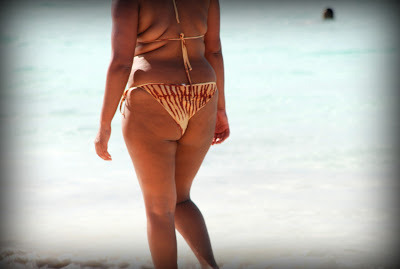 Ee-eh! can be quite eloquent.Say you hear some juicy gossip, something along the lines of, "That guy, the pillar of the community that has three kids and the supermodel wife--know him? Well, my friend Nico saw him at a gay bar last night. And no, he wasn't just having a drink." Your response--verbal or otherwise--would be...
Ee-eh! can be quite eloquent.Say you hear some juicy gossip, something along the lines of, "That guy, the pillar of the community that has three kids and the supermodel wife--know him? Well, my friend Nico saw him at a gay bar last night. And no, he wasn't just having a drink." Your response--verbal or otherwise--would be...
Eeeeeee-eh!
You're getting out of your car with two bags of groceries, you drop one, all those cans roll every which way on the sidewalk and into the street, you'd curse yourself with a not-quite-silent Ee-eh!
You arrive at your hotel and find that you've been upgraded. To the Presidential Suite. For free. Ee-eh! Then at check-out you discover that "free" upgrade wasn't so free after all. Eeeee-eh!
You get the point.
Feel like sharing any Ee-eh! situations of your own? Would love to hear 'em.
Thanks for dropping by! Hope you enjoyed the post. If you're visiting any other A-Z Bloggers, maybe you'll find a post that you can comment Ee-eh! on, just for kicks :)
It sounds like this:
 Ee-eh! That's a big-ass ship.What does it convey? Surprise. Dismay. Amazement. Shock. Depending on the situation, it might be used positively--or very, very negatively.
Ee-eh! That's a big-ass ship.What does it convey? Surprise. Dismay. Amazement. Shock. Depending on the situation, it might be used positively--or very, very negatively.If I tell you I won the lottery and now have fifteen-point-six million euros in my account, you would say...
Ee-eh!
 Ee-eh! can be quite eloquent.Say you hear some juicy gossip, something along the lines of, "That guy, the pillar of the community that has three kids and the supermodel wife--know him? Well, my friend Nico saw him at a gay bar last night. And no, he wasn't just having a drink." Your response--verbal or otherwise--would be...
Ee-eh! can be quite eloquent.Say you hear some juicy gossip, something along the lines of, "That guy, the pillar of the community that has three kids and the supermodel wife--know him? Well, my friend Nico saw him at a gay bar last night. And no, he wasn't just having a drink." Your response--verbal or otherwise--would be...Eeeeeee-eh!
You're getting out of your car with two bags of groceries, you drop one, all those cans roll every which way on the sidewalk and into the street, you'd curse yourself with a not-quite-silent Ee-eh!
You arrive at your hotel and find that you've been upgraded. To the Presidential Suite. For free. Ee-eh! Then at check-out you discover that "free" upgrade wasn't so free after all. Eeeee-eh!
You get the point.
Feel like sharing any Ee-eh! situations of your own? Would love to hear 'em.
Thanks for dropping by! Hope you enjoyed the post. If you're visiting any other A-Z Bloggers, maybe you'll find a post that you can comment Ee-eh! on, just for kicks :)
Published on April 04, 2013 23:00
April 3, 2013
A to Z: D is for Dushi!
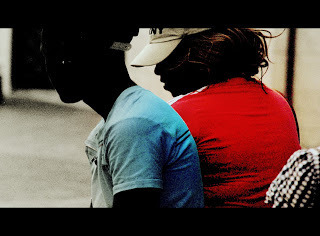 One of Curaçao's remarkable qualities is its inhabitants' flair for languages. Everyone speaks four--yes, four: Dutch, the official language; Papiamentu, the local language; Spanish, because of Venezuelan TV; and English, to communicate with the world. Some schools have the gall to teach German or French. Sometimes German and French.
One of Curaçao's remarkable qualities is its inhabitants' flair for languages. Everyone speaks four--yes, four: Dutch, the official language; Papiamentu, the local language; Spanish, because of Venezuelan TV; and English, to communicate with the world. Some schools have the gall to teach German or French. Sometimes German and French.It's almost too easy to integrate here.
But them locals do love their language, and the smile that lights up their faces when you, a foreigner, speaks even a mispronounced word in Papiamentu is well worth the effort.
That's why today Quiet Laughter offers you a Crash Course in Papiamentu!
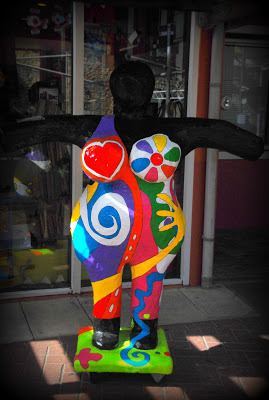 Chichi Curaçao, the island's most
Chichi Curaçao, the island's mostpopular souvenir, embodies dushiness.English: "That's awesome!"
Papiamentu: "Dushi, yu!"
[DOO-she, yoo]
English: "This tastes great!"
Papiamentu: "Ta hopi dushi!"
[Tah HOH-pee DOO-shee]
English: "I love this place!"
Papiamentu: "Ta hopi dushi!"
[Tah HOH-pee DOO-shee]
English: "Baby, come here."
Papiamentu: "Dushi, bin aki."
[DOO-she, bean AH-kee]
English: "Excuse me, ma'am/sir/miss."
Papiamentu: "Sorry, dushi."
[SOH-ree, DOO-shee]
English: "Tastes sweet."
Papiamentu: "Ta dushi."
[Tah DOO-she]
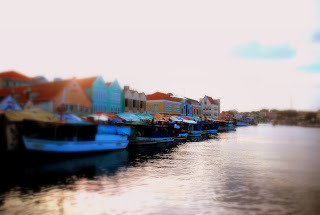 The floating market in Punda (downtown), where
The floating market in Punda (downtown), whereeveryone goes for the dushiest fruit.Dushi is the operating word in Papiamentu, and not just because of its multifunctional applications.
Dushi embodies the spirit of the language--of the culture, even. Things that taste good, even when they're salty or bitter, i.e., not even close to sweet, are still qualified as dushi.
Your sweetheart is, of course, your dushi, but so are most strangers. Waiters and waitresses, certainly. Children, for sure. The girl behind the supermarket cashier will call you dushi, and no, she's not flirting. If you're a woman, the guy at the gas station will call you dushi, and he's not flirting either. Well... not necessarily.
Dushi is also used to describe a good party, a nice relaxed evening at home, an especially challenging swim, a great gift. Pretty much anything good, in Curaçao, is dushi.
Have a dushi day, everyone, and thanks for stopping by. Make sure to visit the other A-Z bloggers--lots of dushi friends to be made.
Published on April 03, 2013 23:00
April 2, 2013
A to Z: C is for Curaçao
Ah, finally: dushi Kòrsou. (More tomorrow on Dushi, for D day.)
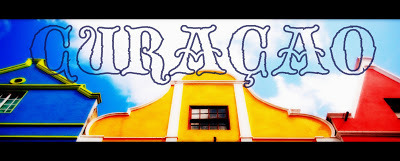
The most popular question about Curaçao (besides where is it, which, if you read the A post, you're already among the elite 3%* of the world's population who can answer that) is about its name.
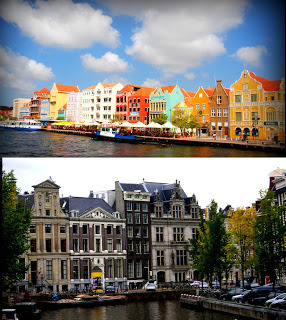 Aside from grey and drab vs. bright and fun,
Aside from grey and drab vs. bright and fun,
you do see the similarities, right?What does it mean? Where does it come from? Is it Portuguese? Spanish? Dutch? No, couldn't be Dutch. But Portuguese... The word for heart in the language of samba and cachaça is coração--that's pretty close, isn't it?
But there's another theory: the island's first inhabitants were Arawak indians that may or may not have called themselves Curacoa or, perhaps, Curaçao.
The thing about Curaçao is that there's simply too many possibilities. Not just for explaining the name.
Think about it: it's a Caribbean island that belongs to the Kingdom of The Netherlands (more on that for G day), thus has a definite European influence.
Lots of Dutch people move here when they retire. Lots vacation here regularly, even own second homes or businesses here. On finishing high school, most Curaçao kids go to Holland for college. That shapes them in ways those of us that grew up in a single country can't even begin to fathom.
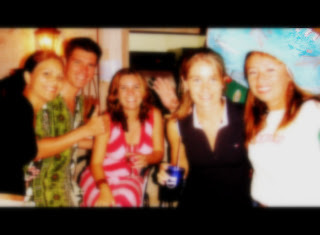 UN in the Caribbean. From left to right:
UN in the Caribbean. From left to right:
Venezuela, Curaçao, Italy, hand of unknown nationality,
Denmark, Mexico. But Curaçao is firmly rooted in Latin America, too. Just off the coast of Venezuela (on clear days you can see the mountain range of Caracas), but with European-style government and a thriving finance industry, it's only logical that this island be a magnet for immigrants. Colombian and Venezuelan, certainly, but also from other parts in the Caribbean: Dominican Republic, Haiti, Jamaica, Trinidad & Tobago. From further south, too: Argentina, Chile, Uruguay, Brazil.
(No, not a lot of Mexicans. A river's easier to cross than the Caribbean.)
And then there's the local Antillean population, another sincretism: descended from African slaves brought here by slave traders in the 1700's and 1800's, mixed with the Dutch and Portuguese settlers, later with Latin and Asian immigrants. So rich, so much tradition to choose from.
Curaçao is the original melting pot of culture. And contrast.
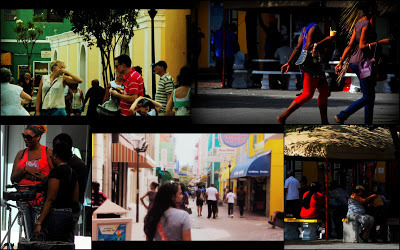 Tourists, locals, Latin, European... Impossible to tell apart.
Tourists, locals, Latin, European... Impossible to tell apart.
European / Latin. Black / white. Laid-back attitude / 12-hour working days. Dry, semi-desertic landscape / the bluest ocean you'll ever see. Red earth baked into powder by a sun so strong its heat pushes you down / white beaches of coral pounded into sand by eons of tides. Friendly faces / surly service. Luxury villas / hovels and homeless.
In ten years, I've barely scratched the surface of what this island--its history, its inhabitants, its future--has to offer.
Go on, take a hop over to the other A-Z Bloggers. Share the love!
*Yeah, totally made up that figure.

The most popular question about Curaçao (besides where is it, which, if you read the A post, you're already among the elite 3%* of the world's population who can answer that) is about its name.
 Aside from grey and drab vs. bright and fun,
Aside from grey and drab vs. bright and fun,you do see the similarities, right?What does it mean? Where does it come from? Is it Portuguese? Spanish? Dutch? No, couldn't be Dutch. But Portuguese... The word for heart in the language of samba and cachaça is coração--that's pretty close, isn't it?
But there's another theory: the island's first inhabitants were Arawak indians that may or may not have called themselves Curacoa or, perhaps, Curaçao.
The thing about Curaçao is that there's simply too many possibilities. Not just for explaining the name.
Think about it: it's a Caribbean island that belongs to the Kingdom of The Netherlands (more on that for G day), thus has a definite European influence.
Lots of Dutch people move here when they retire. Lots vacation here regularly, even own second homes or businesses here. On finishing high school, most Curaçao kids go to Holland for college. That shapes them in ways those of us that grew up in a single country can't even begin to fathom.
 UN in the Caribbean. From left to right:
UN in the Caribbean. From left to right: Venezuela, Curaçao, Italy, hand of unknown nationality,
Denmark, Mexico. But Curaçao is firmly rooted in Latin America, too. Just off the coast of Venezuela (on clear days you can see the mountain range of Caracas), but with European-style government and a thriving finance industry, it's only logical that this island be a magnet for immigrants. Colombian and Venezuelan, certainly, but also from other parts in the Caribbean: Dominican Republic, Haiti, Jamaica, Trinidad & Tobago. From further south, too: Argentina, Chile, Uruguay, Brazil.
(No, not a lot of Mexicans. A river's easier to cross than the Caribbean.)
And then there's the local Antillean population, another sincretism: descended from African slaves brought here by slave traders in the 1700's and 1800's, mixed with the Dutch and Portuguese settlers, later with Latin and Asian immigrants. So rich, so much tradition to choose from.
Curaçao is the original melting pot of culture. And contrast.
 Tourists, locals, Latin, European... Impossible to tell apart.
Tourists, locals, Latin, European... Impossible to tell apart.European / Latin. Black / white. Laid-back attitude / 12-hour working days. Dry, semi-desertic landscape / the bluest ocean you'll ever see. Red earth baked into powder by a sun so strong its heat pushes you down / white beaches of coral pounded into sand by eons of tides. Friendly faces / surly service. Luxury villas / hovels and homeless.
In ten years, I've barely scratched the surface of what this island--its history, its inhabitants, its future--has to offer.
Go on, take a hop over to the other A-Z Bloggers. Share the love!
*Yeah, totally made up that figure.
Published on April 02, 2013 23:00
April 1, 2013
A to Z: B is for Bonaire

Bonaire. Boneiru, in Papiamentu (more on that for D day). Divers' paradise. Hippie haven. The most laid-back atmosphere in the ABC islands. And, as of 2012, a province of The Netherlands.
We'll leave the politics for G day (or maybe skip them altogether). This post is all about aaaaaahhhh--relaxation. Blissing out. Zen. It's in the air even as you board the mosquito plane that hops over from Curaçao.
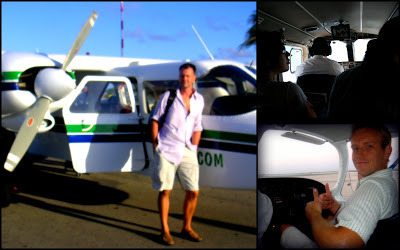
Very small plane. Seats eight--including the pilot. Who sometimes lets an especially friendly passenger drive. No, seriously. Look at said friendly passenger's overwhelmingly competent thumbs-up. While the pilot reads his newspaper, even catches up on beauty sleep.
Or maybe not anymore, after that little mishap in 2009. Haven't been to Bonaire since 2008 myself.
This is what arriving in Bonaire looks like:
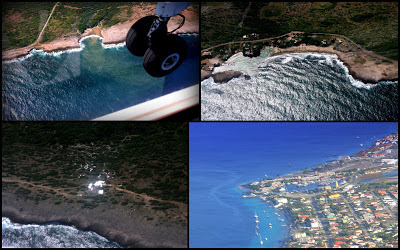
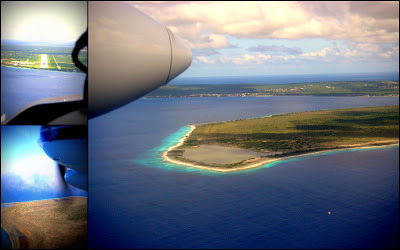
See that huge runway in the pic above (top left corner)? You're probably wondering how much use it gets in an island with only 16500 inhabitants. Answer: a LOT. KLM operates 13 roundtrip flights a week during winter, and those big-ass 747s need a lot of space to land and take off.
16500 inhabitants. In just under 300 sq. km. That's to say, most of the island is empty of humans.
But not life.
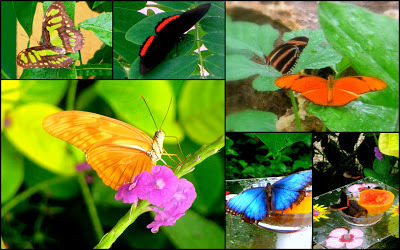 Butterfly farm @ Bonaire
Butterfly farm @ Bonaire
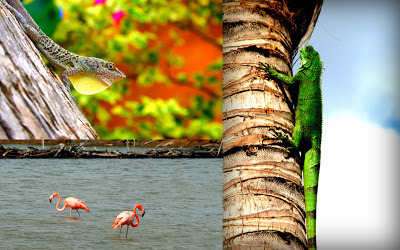 Meanwhile, outside the farm...And that's just above the surface. Underwater is a whole 'nother world.
Meanwhile, outside the farm...And that's just above the surface. Underwater is a whole 'nother world.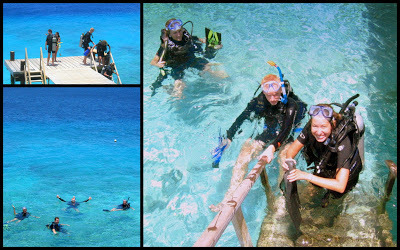 That's me with the big smile.Just look at that water. It's so clear you can see for miles. Ok, meters. Lots of meters. On night dives, especially if there's a full moon, you might as well keep the dive light off. Then again, those six-foot tarpons swimming alongside you are kind of freaky at first. Especially in the dark.
That's me with the big smile.Just look at that water. It's so clear you can see for miles. Ok, meters. Lots of meters. On night dives, especially if there's a full moon, you might as well keep the dive light off. Then again, those six-foot tarpons swimming alongside you are kind of freaky at first. Especially in the dark.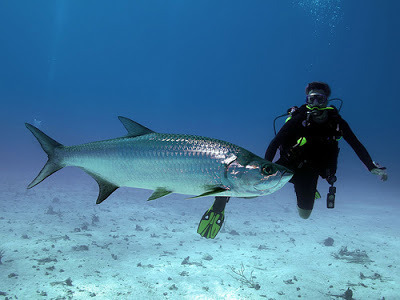 You thought I was joking about the 6' tarpon? I'm not.
You thought I was joking about the 6' tarpon? I'm not.[Photo credit: Gparet (Flickriver)]
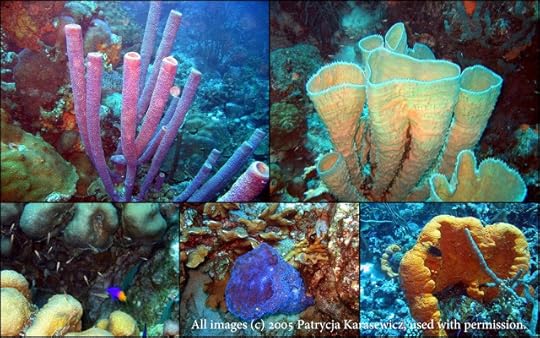 Corals and sponges and fans, oh my.
Corals and sponges and fans, oh my.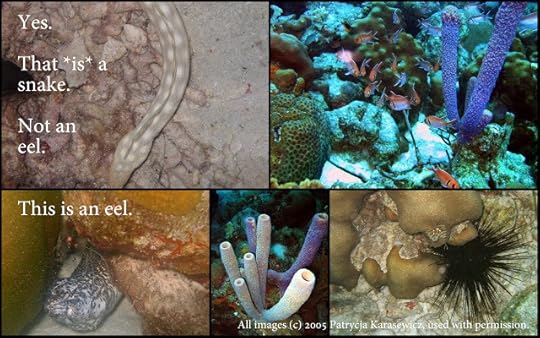 Underwater PYTHONS? Of course. Come to Bonaire.
Underwater PYTHONS? Of course. Come to Bonaire.Seriously. Some f•ckin' awesome stuff down there, by night or by day. If you dive and haven't been to Bonaire yet--well, book that ticket.
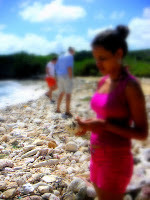 And if you're not? There's more to Bonaire than just underwater adventures, right? Sure. I think. Haha--ok, bad joke.
And if you're not? There's more to Bonaire than just underwater adventures, right? Sure. I think. Haha--ok, bad joke.Look. Bonaire is no Aruba. If you're looking for a party--all-night bar hopping, illegal substances handed out like flyers at election time, boom-boom music, the works... Please do us all a favor and don't come to Bonaire. Bonaire does not like you. If, however, you're a flip-flops-wherever-I-go, sand-between-my-toes-24-7, Pink-Floyd's-the-bomb person... Then Bonaire loves you and shall do forever.
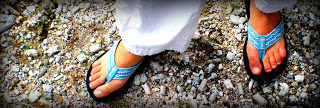 Typical Bonaire weekend plan: a group of friends, a rented (borrowed, or otherwise acquired) bungalow, two or three bathing suits (so you always have a dry one to change into), a few bottles of whatever spirits put you in a conversational mood.
Typical Bonaire weekend plan: a group of friends, a rented (borrowed, or otherwise acquired) bungalow, two or three bathing suits (so you always have a dry one to change into), a few bottles of whatever spirits put you in a conversational mood.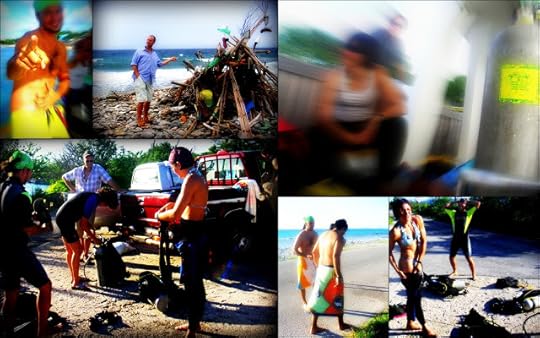
The divers dive, non-divers lounge by the beach (or cliff) with the gear (and the car). Dinner is prepared on a grill outside, where the breeze can soothe sunburnt skin. Plates are passed around, laughter and garlic shrimp compete for your attention. Lounge chairs, a couple of hammocks (that everyone fights over), a couple of glasses of those previously mentioned spirits. Good conversation, maybe a book you simply can't put down.
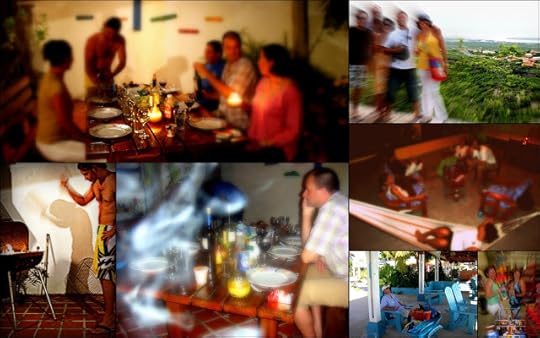
In terms of renewal of soul and mind, Bonaire puts the best spa weekend to shame.
Thanks, Patrycja, for taking those amazing underwater shots. That was one awesome trip to Bonaire!
Thanks for stopping by, everyone. Remember to visit the other A-Z bloggers--some outstanding writers out there.
Published on April 01, 2013 23:00
March 31, 2013
A to Z: A is for Antilles
Welcome to the searing energy of the A to Z Blogging Challenge! This year Quiet Laughter has picked an A-to-Z of FAQs to unveil for you, beloved audience, the secrets of the island life.
Where--and what--the heck is Curaçao?
Because we've got to start somewhere, let's go with where.
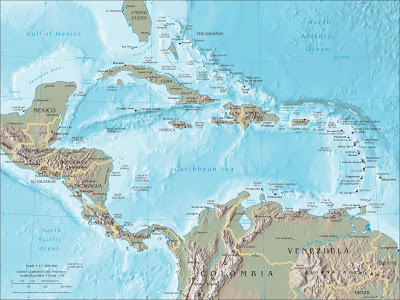 Click on the image to enlarge it. Pretty cool map.The Antilles (ant-EE-lees in English, antees in French) is just a fancy name for the Caribbean islands. You know, that archipelago that creates a curve from the tip of the Yucatan peninsula to Venezuela, and which encloses the Caribbean sea.
Click on the image to enlarge it. Pretty cool map.The Antilles (ant-EE-lees in English, antees in French) is just a fancy name for the Caribbean islands. You know, that archipelago that creates a curve from the tip of the Yucatan peninsula to Venezuela, and which encloses the Caribbean sea.
At the top you've got the Greater Antilles--that's to say, the big islands: Cuba, Hispaniola (Dominican Republic and Haiti), Puerto Rico, and Jamaica. The Cayman Islands are also included, although they're anything but big.
(Which, once again, proves that size has nothing to do with anything.)
Then, making up the real "curve" on the right and stretching all the way down along the coast of Venezuela (look closely--yep, there's little dots of land there, too), I present to you--taaah-daaaah!--the Lesser Antilles. The tiny ones, the secluded ones, the names you hear every now and then in the news (usually during hurricane season) and couldn't place on a map to save your life: Barbuda, Dominica, Saba, Guadeloupe. Names full of sun and palm fronds waving in a warm sea breeze, margaritas and cold beer, sexy women of long legs and full lips, water so turquoise it puts Photoshop to shame.
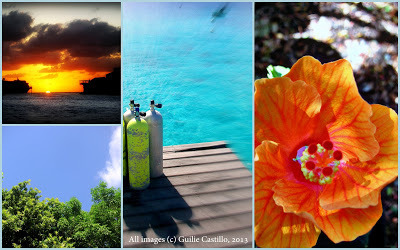
The Lesser Antilles have 20 island-states, and some of those are comprised of more than one island. Antigua and Barbuda, a single state, is made up of not one, not two, but three islands. Guadeloupe, same thing. St. Martin is one island but two states: St. Martin (French) and Sint Maarten (Dutch).
Which is why someone thought, "Let's make this part of the world even more confusing," and came up with three further subdivisions:
The Leeward Islands are the northernmost of the Caribbean curve. The Windward Islands, the larger of the Lesser Antilles, make up the southernmost part of the curve. And the Leeward Antilles, where Curaçao--finally--is, make up the line along the Venezuelan coast.
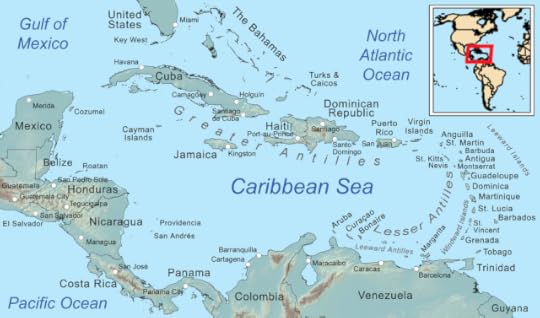 No, that's not Barcelona, Spain.Funky bit of trivia, courtesy of Wikipedia: the name Antilles comes from an old medieval term, Antilia, a mythical group of islands far to the west of the Iberian peninsula that a certain Zuane Pizzigano "discovered." One assumes he did, since he included them in his 1424 nautical chart, for the first time in history and long before Columbus set the record straight. The fact that he was a cartographer, not a sailor, obviously didn't raise any red flags, because from there on out, every reputable chart included Antilia.
No, that's not Barcelona, Spain.Funky bit of trivia, courtesy of Wikipedia: the name Antilles comes from an old medieval term, Antilia, a mythical group of islands far to the west of the Iberian peninsula that a certain Zuane Pizzigano "discovered." One assumes he did, since he included them in his 1424 nautical chart, for the first time in history and long before Columbus set the record straight. The fact that he was a cartographer, not a sailor, obviously didn't raise any red flags, because from there on out, every reputable chart included Antilia.
 No idea is truly novel.Legend had it that, at the time of the Muslim conquest of Spain (711-788 AC), a bunch of bishops escaped the invading horde and set sail to the west, where they found these islands--Antilia, Satanazes, Royllo, and Tanmar--and founded seven settlements.
No idea is truly novel.Legend had it that, at the time of the Muslim conquest of Spain (711-788 AC), a bunch of bishops escaped the invading horde and set sail to the west, where they found these islands--Antilia, Satanazes, Royllo, and Tanmar--and founded seven settlements.
Kinda makes one think of the Puritan separatists fleeing England in the 17th century.
In any case, I think the name is quite apropos. The Caribbean is, after all, the land where magic realism is reality. That the name comes from a mythical place in fifteenth-century charts is pure serendipity.
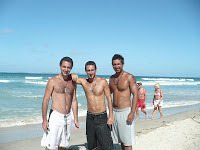 Isla Margarita. Just add alcohol.
Isla Margarita. Just add alcohol.
Photo credit: viajeros.comI digress.
So Curaçao, and its sister islands of Bonaire (more on that tomorrow) and Aruba (the Holloway drama made the Friendly Island infamous worldwide), are part of the Leeward Antilles. The other islands in this group all belong to Venezuela, and include Isla Margarita, Venezuela's South Padre Island.
Aruba, Bonaire, and Curaçao make up the ABC Islands, which used to be part of the country known as Netherlands Antilles, together with Saba, St. Eustatius, and Sint Maarten in the northern Leeward Islands. Yep, used to. Because, you see, I happen to live in a country that has ceased to exist.
But you'll have to wait until G day to find out about that little--or not so little--drama.
In the meantime, now you know exactly where in the world Quiet Laughter resides. You may now sleep at night.
Remember to visit the other A-to-Z bloggers--some pretty awesome people out there!
Where--and what--the heck is Curaçao?
Because we've got to start somewhere, let's go with where.
 Click on the image to enlarge it. Pretty cool map.The Antilles (ant-EE-lees in English, antees in French) is just a fancy name for the Caribbean islands. You know, that archipelago that creates a curve from the tip of the Yucatan peninsula to Venezuela, and which encloses the Caribbean sea.
Click on the image to enlarge it. Pretty cool map.The Antilles (ant-EE-lees in English, antees in French) is just a fancy name for the Caribbean islands. You know, that archipelago that creates a curve from the tip of the Yucatan peninsula to Venezuela, and which encloses the Caribbean sea.At the top you've got the Greater Antilles--that's to say, the big islands: Cuba, Hispaniola (Dominican Republic and Haiti), Puerto Rico, and Jamaica. The Cayman Islands are also included, although they're anything but big.
(Which, once again, proves that size has nothing to do with anything.)
Then, making up the real "curve" on the right and stretching all the way down along the coast of Venezuela (look closely--yep, there's little dots of land there, too), I present to you--taaah-daaaah!--the Lesser Antilles. The tiny ones, the secluded ones, the names you hear every now and then in the news (usually during hurricane season) and couldn't place on a map to save your life: Barbuda, Dominica, Saba, Guadeloupe. Names full of sun and palm fronds waving in a warm sea breeze, margaritas and cold beer, sexy women of long legs and full lips, water so turquoise it puts Photoshop to shame.

The Lesser Antilles have 20 island-states, and some of those are comprised of more than one island. Antigua and Barbuda, a single state, is made up of not one, not two, but three islands. Guadeloupe, same thing. St. Martin is one island but two states: St. Martin (French) and Sint Maarten (Dutch).
Which is why someone thought, "Let's make this part of the world even more confusing," and came up with three further subdivisions:
The Leeward Islands are the northernmost of the Caribbean curve. The Windward Islands, the larger of the Lesser Antilles, make up the southernmost part of the curve. And the Leeward Antilles, where Curaçao--finally--is, make up the line along the Venezuelan coast.
 No, that's not Barcelona, Spain.Funky bit of trivia, courtesy of Wikipedia: the name Antilles comes from an old medieval term, Antilia, a mythical group of islands far to the west of the Iberian peninsula that a certain Zuane Pizzigano "discovered." One assumes he did, since he included them in his 1424 nautical chart, for the first time in history and long before Columbus set the record straight. The fact that he was a cartographer, not a sailor, obviously didn't raise any red flags, because from there on out, every reputable chart included Antilia.
No, that's not Barcelona, Spain.Funky bit of trivia, courtesy of Wikipedia: the name Antilles comes from an old medieval term, Antilia, a mythical group of islands far to the west of the Iberian peninsula that a certain Zuane Pizzigano "discovered." One assumes he did, since he included them in his 1424 nautical chart, for the first time in history and long before Columbus set the record straight. The fact that he was a cartographer, not a sailor, obviously didn't raise any red flags, because from there on out, every reputable chart included Antilia. No idea is truly novel.Legend had it that, at the time of the Muslim conquest of Spain (711-788 AC), a bunch of bishops escaped the invading horde and set sail to the west, where they found these islands--Antilia, Satanazes, Royllo, and Tanmar--and founded seven settlements.
No idea is truly novel.Legend had it that, at the time of the Muslim conquest of Spain (711-788 AC), a bunch of bishops escaped the invading horde and set sail to the west, where they found these islands--Antilia, Satanazes, Royllo, and Tanmar--and founded seven settlements.Kinda makes one think of the Puritan separatists fleeing England in the 17th century.
In any case, I think the name is quite apropos. The Caribbean is, after all, the land where magic realism is reality. That the name comes from a mythical place in fifteenth-century charts is pure serendipity.
 Isla Margarita. Just add alcohol.
Isla Margarita. Just add alcohol.Photo credit: viajeros.comI digress.
So Curaçao, and its sister islands of Bonaire (more on that tomorrow) and Aruba (the Holloway drama made the Friendly Island infamous worldwide), are part of the Leeward Antilles. The other islands in this group all belong to Venezuela, and include Isla Margarita, Venezuela's South Padre Island.
Aruba, Bonaire, and Curaçao make up the ABC Islands, which used to be part of the country known as Netherlands Antilles, together with Saba, St. Eustatius, and Sint Maarten in the northern Leeward Islands. Yep, used to. Because, you see, I happen to live in a country that has ceased to exist.
But you'll have to wait until G day to find out about that little--or not so little--drama.
In the meantime, now you know exactly where in the world Quiet Laughter resides. You may now sleep at night.
Remember to visit the other A-to-Z bloggers--some pretty awesome people out there!
Published on March 31, 2013 23:30
March 25, 2013
A-Z Preview
The A-Z madness is almost upon us! And I'm waaaay behind on writing my posts. *Sigh* But I'm working hard at them, because I'm excited about my theme this year.
 Image credit: Don Genaro Curaçao Appartements [sic]Most of Quiet Laughter's regular readers have asked, at some point or another, the very normal question of where--and what--the heck is Curaçao? No reason to be ashamed; when I came to this island I literally had no clue where I was going. Somewhere in the Caribbean, yes, but where? Had to be close to Brazil, right? CURAÇAO--definitely Brazilian. And, thus, paradisiac rainforests, secret waterfalls, hibiscus splashing color everywhere... Right?
Image credit: Don Genaro Curaçao Appartements [sic]Most of Quiet Laughter's regular readers have asked, at some point or another, the very normal question of where--and what--the heck is Curaçao? No reason to be ashamed; when I came to this island I literally had no clue where I was going. Somewhere in the Caribbean, yes, but where? Had to be close to Brazil, right? CURAÇAO--definitely Brazilian. And, thus, paradisiac rainforests, secret waterfalls, hibiscus splashing color everywhere... Right?
Wrong. Oh, I was wrong about so many things that 4th of July in 2003 when I hopped all over the Caribbean to get here. The first "wrong": my stay was temporary. Six months only.
Here we are, a decade later.
I fell in love. Pure and simple. Yes, with a man--but before I met him, I was already having this intense affair with Curaçao. I didn't care there were no rainforests (cacti and barren rock, anyone?) or waterfalls. (But look--just look at this display of Nature. Who needs freakin' waterfalls?)
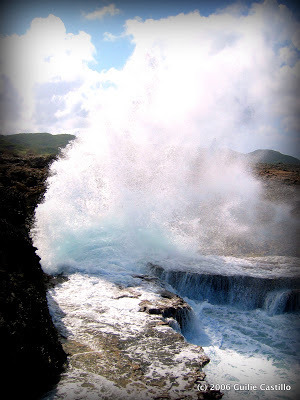 In Curaçao, water falls up.And so, for the 2013 A-Z Challenge, I've made it my mission to not just put Curaçao on the map for you, but to put it into your heart.
In Curaçao, water falls up.And so, for the 2013 A-Z Challenge, I've made it my mission to not just put Curaçao on the map for you, but to put it into your heart.
(Yes, we have a guest bedroom. Hope you don't mind a fluctuating population of dogs.)
 Image credit: Don Genaro Curaçao Appartements [sic]Most of Quiet Laughter's regular readers have asked, at some point or another, the very normal question of where--and what--the heck is Curaçao? No reason to be ashamed; when I came to this island I literally had no clue where I was going. Somewhere in the Caribbean, yes, but where? Had to be close to Brazil, right? CURAÇAO--definitely Brazilian. And, thus, paradisiac rainforests, secret waterfalls, hibiscus splashing color everywhere... Right?
Image credit: Don Genaro Curaçao Appartements [sic]Most of Quiet Laughter's regular readers have asked, at some point or another, the very normal question of where--and what--the heck is Curaçao? No reason to be ashamed; when I came to this island I literally had no clue where I was going. Somewhere in the Caribbean, yes, but where? Had to be close to Brazil, right? CURAÇAO--definitely Brazilian. And, thus, paradisiac rainforests, secret waterfalls, hibiscus splashing color everywhere... Right?Wrong. Oh, I was wrong about so many things that 4th of July in 2003 when I hopped all over the Caribbean to get here. The first "wrong": my stay was temporary. Six months only.
Here we are, a decade later.
I fell in love. Pure and simple. Yes, with a man--but before I met him, I was already having this intense affair with Curaçao. I didn't care there were no rainforests (cacti and barren rock, anyone?) or waterfalls. (But look--just look at this display of Nature. Who needs freakin' waterfalls?)
 In Curaçao, water falls up.And so, for the 2013 A-Z Challenge, I've made it my mission to not just put Curaçao on the map for you, but to put it into your heart.
In Curaçao, water falls up.And so, for the 2013 A-Z Challenge, I've made it my mission to not just put Curaçao on the map for you, but to put it into your heart.(Yes, we have a guest bedroom. Hope you don't mind a fluctuating population of dogs.)
Published on March 25, 2013 08:57
March 14, 2013
A little inspiration... (Ira Glass)
Something to keep the juices flowing.
Published on March 14, 2013 11:05



